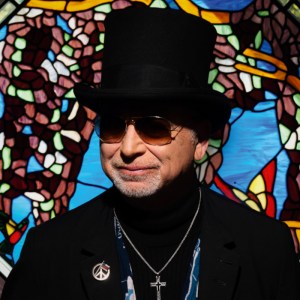The 13-minute-long music video for Michael Jackson’s “Thriller” premiered on MTV on December 2, 1983, and quite frankly, music videos haven’t been the same since. This video is often pointed to as one of the reasons why the music video format is now taken seriously by the entertainment industry. Why? The massive success of the “Thriller” video proved that the format was an invaluable marketing tool and an artform all on its own.
Videos by American Songwriter
Getting into some of the specifics, the video itself cost an estimated $900,000 to create—an unheard-of amount of money for music videos at the time. And on top of that, the video’s plot largely came to life because Jackson “wanted to be turned into a monster, just for fun,” as director John Landis explained in a 2010 interview.
So, what made this music video so monumental? Let’s find out. Unless, of course, you’re afraid of a few monsters…
Pre-production for “Thriller.”
Michael Jackson released “Thriller” as the fourth song on the album of the same name in 1982 via Epic Records. The album became Jackson’s first number one on the U.S. Billboard Top LPs & Tapes chart (now the Billboard 200), and contained other hits like “Billie Jean” and “Beat It.” But, as new music came out—as it inevitably does—the album slipped from the number one position.
Walter Yetnikoff, a CBS Records executive at the time, remembers that Jackson was upset at his dethronement. Jackson was so consumed by the success of his music that Yetikoff remembers getting phone calls from the star late into the night and early in the morning. “Walter, the record isn’t No. 1 anymore,” Yetnikoff remembers Jackson saying. “What are we going to do about it?”
“We’re going to go to sleep and deal with it tomorrow,” Yetnikoff replied.
“He enjoyed being on top,” Larry Stessel, an Epic Records executive, confirmed. “He reveled in it. He didn’t like it when it ended.”
So, Frank DiLeo (the head of promotion at Epic Records) came up with the idea to make a video for “Thriller.” He told Jackson, “It’s simple—all you’ve got to do is dance, sing, and make it scary.”
With wheels turning, Jackson hired Landis to direct the music video after seeing Landis’s 1981 film, An American Werewolf in London. Makeup artist Rick Baker was responsible for turning Jackson into a werecat, and Landis’s wife Deborah Nadoolman designed the costumes—including Jackson’s iconic red jacket. (Side note: Nadoolman had previously worked on the film Raiders of the Lost Ark.) Choreographer Michael Peters was hired again after he choreographed Jackson’s “Beat It” music video.
And, of course, the female lead in the music video is Ola Ray, a model, and former Playboy Playmate.
The hair-raising details and dance number.
The video itself possesses two plotlines. The opening scenes show Jackson and Ray engaged in a conversation set in the 1950s. In the scene, Jackson asks Ray to be his girlfriend, she accepts, and then Jackson confesses that he’s “not like other guys.” Spoiler alert: He’s a werecat!
Then, jumping back to the ’80s, viewers again see Jackson and Ray. This time, though, they are at the movie theater watching the first scene unfold. Ray is frightened by the horror movie and exits the theater. Jackson follows Ray and they are soon surrounded by zombies. You likely know the rest, and if not, you can watch it below.
Now, getting more granular, several props and stylistic choices were included as nods to popular horror films. Allusions to The Wolf Man (1941), House of Wax (1953), The Mad Magician (1954), The Masque of the Red Death (1964), The Shining (1980), and several other horror films can be detected in the video.
Additionally, the music video’s dance number is quite legendary. In a 1999 interview with MTV, the singer explained the dance number’s genesis. “Usually, you know, it’s an interpretation of the music. It was a delicate thing to work on because I remember my original approach was, ‘How do you make zombies and monsters dance without it being comical?’ So I said, ‘We have to do just the right kind of movement so it doesn’t become something that you laugh at.’ But it just has to take it to another level,” Jackson said.
“So I got in a room with Michael Peters, and he and I together kind of imagined how these zombies move by making faces in the mirror. I used to come to rehearsal sometimes with monster makeup on, and I loved doing that. So he and I collaborated and we both choreographed the piece and I thought it should start like that kind of thing and go into this jazzy kind of step, you know. Kind of gruesome things like that, not too much ballet or whatever,” he concluded.
What’s up with the disclaimer at the beginning and end?
You likely noticed the odd disclaimers that bookend the video.
At the beginning: “Due to my strong personal convictions, I wish to stress that this film in no way endorses a belief in the occult. Michael Jackson.”
At the end: “All characters and events in this film are fictitious. Any similarity to actual events or persons living, dead, (or undead) is purely coincidental.”
These disclaimers, particularly the one at the beginning, were a result of Jackson’s beliefs at the time. During filming, Jackson was still a Jehovah’s Witness, as his mother had also been. (He would later disassociate with Jehovah’s Witnesses in 1987.) So, in order to remain in good standing with the Witnesses, the disclaimers were Jackson’s attempt to reassure them that he was not promoting “demonology.”
Spooky, huh?
Photo Courtesy of Epic Records
